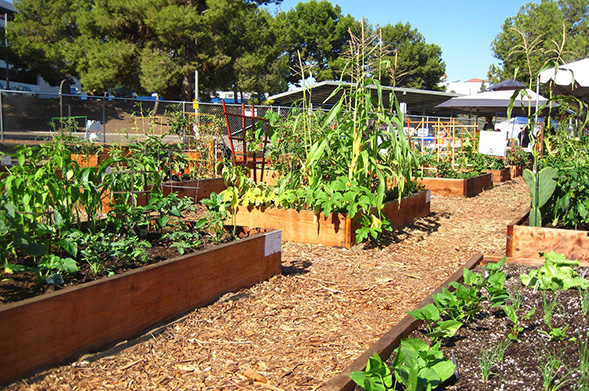SDSU Children's Center Goes Green
The SDSU Children's Center has implemented a number of eco-friendly measures to eliminate carbon emissions.

In response to a national sustainability initiative aimed at bringing greenhouse gas emissions on college campuses to zero, the San Diego State University Children’s Center has implemented a number of eco-friendly measures to reduce its carbon footprint. One of them is a collaboration with the College Area Community Garden (CACG).“Our collaboration with the College Area Community Garden for the composting project is a great way to get children involved and teach them about being environmentally responsible.”
Members of the CACG began picking up food waste from the SDSU Children’s Center last April. The team then turns this food waste into compost for use in the CACG.
In just under a year, the program has eliminated two and three-quarter tons of food scraps and one and three-quarter tons of tree trimmings from the landfill. This has also helped eliminate six metric tons of CO2E emissions, which is the equivalent to removing 15 and one-half cars off from the road.
“Our collaboration with the College Area Community Garden for the composting project is a great way to get children involved and teach them about being environmentally responsible,” said Sara Sanders, assistant director of the Children’s Center.
The Children’s Center has its own small garden where the children plant and care for seasonal crops. Children from the center will also take part in field trips to the CACG in order to further enhance their educational experience.
Learning about sustainability
The SDSU Children's Center has implemented a “Children and Nature” curriculum to teach children about sustainability. Following the California Preschool Curriculum Guideline, the center has made it a goal to ensure children develop an interest in a wider range of natural phenomena and concern for the natural world.Staff members teach the little ones about the impact humans have on the environment and how to conserve through recycling and reusing materials. They are also incorporating books focused on the environment and climate into the curriculum.
A bigger effort
The SDSU Children’s Center’s collaboration with the CACG is part of an ongoing sustainability effort across campus. The U.S. Green Building Council recently awarded its second-highest level of certification, LEED-Gold, to the Children’s Center in recognition of its efforts to reduce landfill waste.Additionally, the center converted to LED bulbs, installed low-flow toilets and water features to reduce water usage, replaced paper towels with microfiber cloths, converted to eco-friendly nontoxic cleaners, and implemented solar panels.
Several other buildings at SDSU have also been recognized with LEED certifications, including Storm and Nasatir Halls, Zura Hall, the Conrad Prebys Aztec Student Union and the Aztec Recreation Center. Associated Students has committed to have all of its buildings LEED-certified and has partnered with Facilities Services to install hydration systems around campus to cut back on the environmental impacts of plastic water bottles.
“We are on the cusp of becoming a campus with solid sustainability practices, with sustainability infused into our culture,” said Tom Abrams, the assistant director of campus sustainability. “We have been building the foundations for this effort and I'm excited to see what happens next.”



